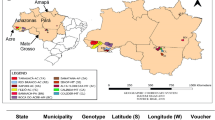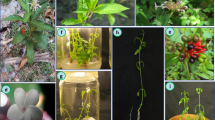Abstract
We investigated the ephedrine alkaloid [(−)-ephedrine and (+)-pseudoephedrine] composition ratio of a crude Chinese herbal drug described in the Japanese Pharmacopoeia ‘Ephedra herb (Chinese name: Mahuang)’. There were marked changes in the alkaloid composition ratio of wild plants in areas where both male and female clusters coexisted. However, in genetically homogeneous areas with the growth of male or female clusters alone, all of the coefficients of the regression lines were positive, but each gradient varied. This suggests that the alkaloid composition ratio has a clear tendency in each individual. Based on this, we cultivated individuals for vegetative propagation, and evaluated the alkaloid content ratio. Those propagated by separating the roots showed a specific tendency regardless of the cultivation area (Wakayama, Tanegashima). Those propagated by separating the herbaceous stem showed a specific tendency regardless of the soil or harvest time. In addition, we surveyed the (−)-ephedrine content ratio of 3- to 6-year-old strains. There was a high positive correlation coefficient between the previous and subsequent years. These findings suggest that the ephedrine alkaloid composition ratio of Ephedra herb depends on genetic factors, but not on environmental factors or the growth period.





Similar content being viewed by others
References
Society of Japanese Pharmacopoeia (2011) The Japanese pharmacopoeia, 16th edn. Yakuji Nippo, Tokyo, p 1589
Liu Z, Shi Q, Yang Y, Li R-J, Zhu Y-Y, Bai G (2009) A comparative study of effect to asthma and mechanism in ephedrine and pseudoephedrine. Zhong Cao Yao 40(5):771–774 in Chinese
Laitinen LA, Empey DW, Bye C, Britton MG, McDonnell K, Hughes DTD (1982) A comparison of the bronchodilator action of pseudoephedrine and ephedrine in patients with reversible airway obstruction. Eur J Clin Pharmacol 23(2):107–109
Akiba K, Miyamoto A, Suzuki T, Anezaki K, Tadano T, Sakurada S, Kisara K (1979) Effects of d-pseudoephedrine on tracheo-bronchial muscle and the cardiovascular system. Folia Pharmacol Japon 75((4):383–390
Hikino Hiroshi, Konno Chohachi, Takata Hiroshi, Tamada Mitsuru (1980) Antiinflammatory principle of Ephedra herbs. Chem Pharm Bull 28(10):2900–2904
Zhang JS, Tian Z, Lou ZC (1989) Quality evaluation of twelve species of Chinese Ephedra (mahuang). Yao Xue Xue Bao 24(11):865–871 in Chinese
Nagase Chiaki (1996) The effect of Chinese herbal medicine Dokkatsu-Kakkon-To (Chinese name: Du-Huo-Ge-Gen-Tang) on the symptom of shoulder stiffness. Clinical Report 30(3):633–643
Liu Ying-Mei, Sheu Shuenn-Jyi, Chiou Shiow-Hua, Chang Hsien-Chang, Chen Yuh-Pan (1993) A comparative study on commercial samples of Ephedrae Herba. Planta Med 59:376–378
The Society for Antibacterial and Antifungal Agents, Japan (1999) 21 century’s herbal medicine. Kampo products. Senisya, Osaka, pp p87–p88
Tanaka T, Ohba K, Kawahara K, Sakai E (1995) Comparison of the constituents of Ephedra herbs from various countries on Ephedrine type alkaloids. Nat Med 49(4):418–424
Wang Li–Li, Kakiuchi Nobuko, Mikage Masayuki (2010) Studies of Ephedra plants in Asia. Part 6: geographical changes of anatomical features and alkaloids content of Ephedra sinica. J Nat Med 64:63–69
Editorial Committee of Guidelines for Good Agricultural Practice of Chinese Crude Drugs (2006) Guidelines for good agricultural practice of Chinese crude drugs. China Agirculture Press, Beijing, pp 840–849 (in Chinese)
Cheng Da-Dun, Guo Ping, Zhao Jun (1992) Seasonal variation of alkaloids contained in Ephedra sinica Herba in Inner Mongolia. Zhongguo Yaoke Daxue xuebao 23(2):82–87 in Chinese
Acknowledgments
Japan Society for the Promotion of Science, Grant-in-Aid for Scientific Research (nos. 13575010, 17405014) supported this study.
Author information
Authors and Affiliations
Corresponding author
Additional information
A part of this study was already reported in the 131th conference of the Pharmaceutical Society of Japan [2011.3, Shizuoka (this conference had to be cancelled due to the disaster)].
Rights and permissions
About this article
Cite this article
Matsumoto, M., Hirayama, M., Ohtomi, N. et al. Influence of genetic factors on the ephedrine alkaloid composition ratio of Ephedra plants. J Nat Med 69, 63–67 (2015). https://doi.org/10.1007/s11418-014-0863-7
Received:
Accepted:
Published:
Issue Date:
DOI: https://doi.org/10.1007/s11418-014-0863-7




